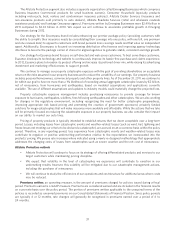Allstate 2012 Annual Report Download - page 127
Download and view the complete annual report
Please find page 127 of the 2012 Allstate annual report below. You can navigate through the pages in the report by either clicking on the pages listed below, or by using the keyword search tool below to find specific information within the annual report.• Expanded our excess and surplus carrier (North Light Specialty) to eight new states in 2011, bringing the total
number of active states to 25.
• In Texas we are ceding wind exposure related to insured property located in wind pool eligible areas along the
coast including the Galveston Islands.
• We have ceased writing new homeowners business in California. We will continue to renew current
policyholders and have a renewal ratio of approximately 91% in California.
• We have ceased writing new business in Florida beyond a modest stance for existing customers who replace
their currently-insured home with an acceptable property. Withdrawal from the property lines was completed
for the Encompass companies operating in Florida.
Hurricanes
We consider the greatest areas of potential catastrophe losses due to hurricanes generally to be major metropolitan
centers in counties along the eastern and gulf coasts of the United States. Usually, the average premium on a property
policy near these coasts is greater than in other areas. However, average premiums are often not considered
commensurate with the inherent risk of loss. In addition and as explained in Note 14 of the consolidated financial
statements, in various states Allstate is subject to assessments from assigned risk plans, reinsurance facilities and joint
underwriting associations providing insurance for wind related property losses.
We have addressed our risk of hurricane loss by, among other actions, purchasing reinsurance for specific states
and on a countrywide basis for our personal lines property insurance in areas most exposed to hurricanes; limiting
personal homeowners new business writings in coastal areas in southern and eastern states; implementing tropical
cyclone deductibles where appropriate; and not offering continuing coverage on certain policies in coastal counties in
certain states. We continue to seek appropriate returns for the risks we write. This may require further actions, similar to
those already taken, in geographies where we are not getting appropriate returns. However, we may maintain or
opportunistically increase our presence in areas where we achieve adequate returns and do not materially increase our
hurricane risk.
Earthquakes
Actions taken to reduce our exposure from earthquake coverage are substantially complete. These actions included
purchasing reinsurance on a countrywide basis and in the state of Kentucky; no longer offering new optional earthquake
coverage in most states; removing optional earthquake coverage upon renewal in most states; and entering into
arrangements in many states to make earthquake coverage available through other insurers for new and renewal
business.
We expect to retain approximately 30,000 PIF with earthquake coverage due to regulatory and other reasons. We
also will continue to have exposure to earthquake risk on certain policies that do not specifically exclude coverage for
earthquake losses, including our auto policies, and to fires following earthquakes. Allstate policyholders in the state of
California are offered coverage through the CEA, a privately-financed, publicly-managed state agency created to provide
insurance coverage for earthquake damage. Allstate is subject to assessments from the CEA under certain
circumstances as explained in Note 14 of the consolidated financial statements.
Fires Following Earthquakes
Actions taken related to our risk of loss from fires following earthquakes include changing homeowners
underwriting requirements in California, purchasing reinsurance for Kentucky personal lines property risks, and
purchasing nationwide occurrence reinsurance, excluding Florida and New Jersey.
Wildfires
Actions we are taking to reduce our risk of loss from wildfires include changing homeowners underwriting
requirements in certain states and purchasing nationwide occurrence reinsurance. Catastrophe losses related to the
Southern California wildfires occurred during 2009 and totaled $76 million.
Reinsurance
A description of our current catastrophe reinsurance program appears in Note 10 of the consolidated financial
statements and a description of program changes as of June 1, 2012 appears in the Property-Liability Claims and Claims
Expense Reserves section of the MD&A.
41
























